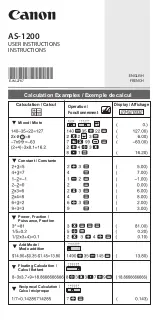
Page 18-10
A plot of frequency count, f
i
, vs. class marks, xM
i
, is known as a frequency
polygon. A plot of the cumulative frequency vs. the upper boundaries is
known as a cumulative frequency ogive. You can produce scatterplots that
simulate these two plots by entering the proper data in columns 1 and 2 of a
new
Σ
DAT matrix and changing the
Type
: to
SCATTER
in the PLOT SETUP
window.
Fitting data to a function y = f(x)
The program
3. Fit data..
, available as option number 3 in the STAT menu,
can be used to fit linear, logarithmic, exponential, and power functions to
data sets (x,y), stored in columns of the
Σ
DAT matrix. In order for this
program to be effective, you need to have at least two columns in your
Σ
DAT
variable.
Example 1 – Fit a linear relationship to the data shown in the table below:
•
First, enter the two rows of data into column in the variable
Σ
DAT by
using the matrix writer, and function STO
Σ
.
•
To access the program
3. Fit data..
, use the following keystrokes:
‚Ù˜˜
@@@OK@@@
The input form will show the current
Σ
DAT,
already loaded. If needed, change your set up screen to the following
parameters for a linear fitting:
x
0 1 2 3 4 5
y
0.5 2.3 3.6 6.7 7.2 11







































